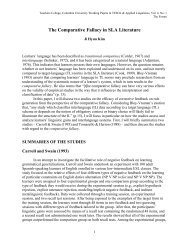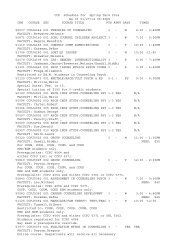UNICEF Mongolia - Teachers College Columbia University
UNICEF Mongolia - Teachers College Columbia University
UNICEF Mongolia - Teachers College Columbia University
Create successful ePaper yourself
Turn your PDF publications into a flip-book with our unique Google optimized e-Paper software.
CHAPTER 2: THE TEACHING WORKFORCE<br />
center schools. 10 By the academic year 2009/2010, the rural-urban gap [using the new terminology]<br />
nearly disappeared; the percentage of teachers with professional qualificaons (methodologist teachers,<br />
lead teachers, and advisor teachers) was 49.6 percent in Ulaanbaatar and 45.9 percent in schools outside<br />
of the capital. The reasons for the rural-urban divide were well studied in the PETS <strong>Mongolia</strong> study, which<br />
found that there was a correlaon between teaching experience and promoon. Schools in urban areas<br />
managed to aract experienced teachers from rural areas, and therefore, the rao of teachers with<br />
professional qualificaons was much higher in urban schools. In addion, the chances of fulfilling the<br />
promoon criteria were bigger in urban schools, because those teachers had easier access to professional<br />
development courses, and the reviewers were in closer geographic proximity. A promoon from the rank<br />
of regular teacher to methodologist requires, for example, a review by the school administraon, and<br />
the Educaon and Culture Department at the provincial level merely needs to be informed. For the next<br />
level—promoon from methodologist to lead teacher—the ECD methodologists review the teacher’s<br />
porolio and observe the teacher’s class. Finally, for the highest rank—promoon from lead teacher to<br />
advisor teacher—reviewers from the central level, based in Ulaanbaatar, must carry out the promoon<br />
review. Over the past five years, the promoon review criteria have remained the same, but the number<br />
of professional development courses offered throughout the country has significantly increased. The<br />
spread of professional development courses has improved equity throughout the country, and the ruralurban<br />
divide with regard to professional qualificaons has almost completely disappeared (if the new<br />
official definion of rural and urban schools is applied). 11<br />
1<br />
2<br />
3<br />
4<br />
5<br />
6<br />
Thirdly, as part of the structural salary reform, the rank supplements were increased by five percent for<br />
each rank. Before 2007, teachers at the rank of methodologist earned only five percent of their base<br />
salary in terms of salary supplement. Similarly, the supplement for lead teachers was ten percent and the<br />
one for advisor teacher was fieen percent. 12<br />
Taken together, these three trends have important implicaons for teacher-related policies. For example,<br />
lead teachers may soon experience a sense of having a “glass ceiling” if the quota for promoons to<br />
the highest salary level is not substanally lied. One of the greatest concerns, uncovered in the PETS<br />
<strong>Mongolia</strong> study in 2006, has to do with the unequal promoon chances of teachers in rural, semi-urban,<br />
and urban schools. In the five years since the study was completed, the professional development<br />
opportunies in rural schools have visibly increased, but the stascal analyses are inconclusive as to<br />
whether the rural-urban divide has really disappeared, due to the terminological changes that were<br />
applied to the definions of rural and urban schools.<br />
2.4. SUBJECT SPECIALIZATIONS<br />
The number of part-me teachers is very small: only 3.2 percent of the teachers (887 teachers) work part-<br />
me. In contrast, 26,358 teachers work full-me. Full-me work is seen as a right of the employee. The<br />
same applies for teachers who are entled to full-me work (unless the teacher is a rered professional).<br />
Even professionals who are hired as teachers for subjects that experience teacher shortage—or for<br />
subjects with only a few weekly instruconal hours (English, informaon technology, physical educaon,<br />
music and fine arts)—are encouraged to work full-me. <strong>Teachers</strong> hired part-me only as excepons. 13<br />
10 World Bank. (2006). <strong>Mongolia</strong>. Public Financing of Educaon. Equity and Efficiency Implicaons [also referred to as PETS <strong>Mongolia</strong><br />
study]. Washington, DC: World Bank.<br />
11 The problemac change in terminology cannot be overstated: the currently used, official methodology for defining “rural<br />
schools” masks the vast differences between soum-center schools and aimag-center schools.<br />
12 Joint Order # 328/131/283 of Ministers of Educaon, Culture and Science, Social Security and Labor, and Finance; see also the<br />
well-research background report of the Finance and Economic Department, MECS (2007). Salary Structure of General Educaon<br />
School <strong>Teachers</strong>. Ulaanbaatar: February 2007.<br />
13 See Joint Order #307/91/237 of the Minister of Educaon, Culture and Science, the Minister of Social Protecon and Labor and<br />
the Minister of Finance, August 31, 2007.<br />
TEACHERS IN MONGOLIA: AN EMPIRICAL STUDY ON RECRUITMENT INTO TEACHING,<br />
PROFESSIONAL DEVELOPMENT, AND RETENTION OF TEACHERS<br />
37


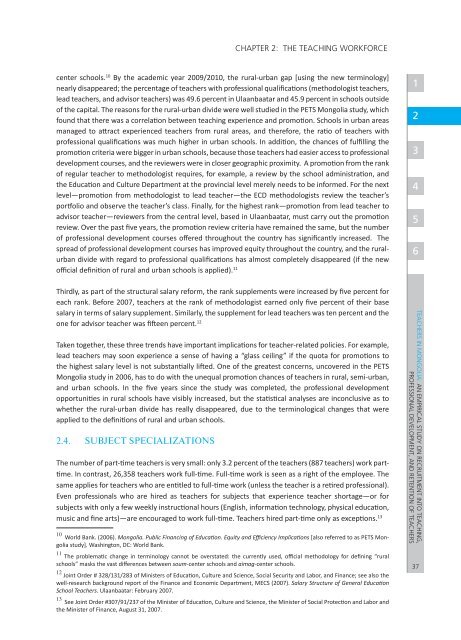
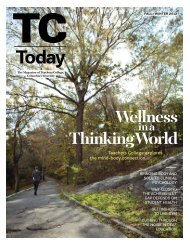

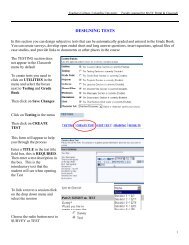

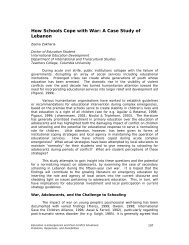

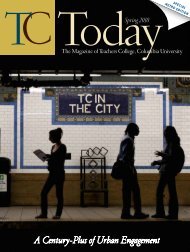
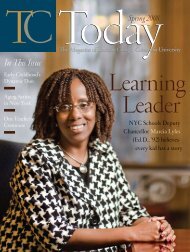



![TC Tod[...].pdf - Teachers College Columbia University](https://img.yumpu.com/27074883/1/190x252/tc-todpdf-teachers-college-columbia-university.jpg?quality=85)

